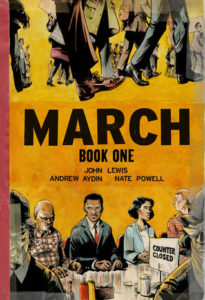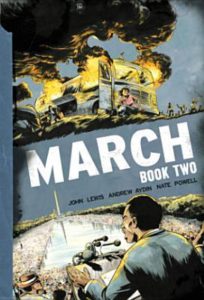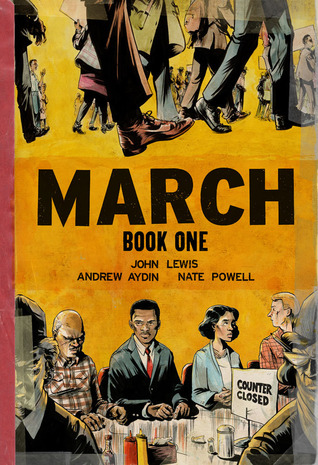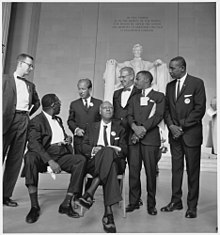March: Book One and March: Book Two
by John Lewis, Andrew Aydin (Co-authors), Nate Powell (Artist)
Blurb:
March is a vivid first-hand account of John Lewis’ lifelong struggle for civil and human rights, meditating in the modern age on the distance traveled since the days of Jim Crow and segregation. Rooted in Lewis’ personal story, it also reflects on the highs and lows of the broader civil rights movement.
 Continuing with my Black History Month project, I finished Representative John Lewis’ trilogy of graphic books: March. These three books are a remarkable achievement and recommended for adults and children alike. Lewis, a true American treasure and Civil Rights icon, wrote a couple of traditional memoirs based on his role in the Civil Rights struggles. This graphic project was inspired by an early “comic” about Dr. Martin Luther King that circulated during those turbulent times and inspired many young people to join the fight. The lead up to, and march for, voting rights in Selma, Alabama is laid out in touching detail.
Continuing with my Black History Month project, I finished Representative John Lewis’ trilogy of graphic books: March. These three books are a remarkable achievement and recommended for adults and children alike. Lewis, a true American treasure and Civil Rights icon, wrote a couple of traditional memoirs based on his role in the Civil Rights struggles. This graphic project was inspired by an early “comic” about Dr. Martin Luther King that circulated during those turbulent times and inspired many young people to join the fight. The lead up to, and march for, voting rights in Selma, Alabama is laid out in touching detail.
Book One is the shortest of the three but covers the most time of the trilogy. It deals with Lewis’ early years, his struggle (even against his parents) to get an education and his growing sense of injustice in the segregated south. John Lewis struggled and “pulled himself up by his bootstraps” against enormous odds. This book lays the foundation for everything that is to come, everything that shaped his personality and made him the formidable man he was to become. It concludes with the successful integration of Nashville, Tennessee’s downtown drug store counters. We get a behind the scenes look at the politics and strategies employed by a dedicated group of young people working to make their world more fair: the first steps in the Civil Rights movement. I particularly liked the framing story–the morning of President Obama’s first inauguration–which gave the narrative poignancy.
Book Two picks up where March: Book One left off, including the framing story of President Obama’s inauguration day. Lewis covers a couple of crucial years: the summer of the Freedom Riders (1961) and culminating with the March on Washington (1963). These years were filled with inspiring acts of pacifist courage in the face of virulent hatred and violence.
 The text was emotionally hard to read and the pictures harder to look at. The artist Nate Powell eerily captures the mad glee of a waitress who dumps a box of soap flakes over the heads of black customers, sprays them with a fire hose, and turns of up the air conditioner; the learned hatred on a boy’s face as he kicks and punches, at his father’s urging, a downed Freedom Rider; and the cold cruelty of “Bull” Connor as he fire hoses and sets vicious dogs on marching black children.
The text was emotionally hard to read and the pictures harder to look at. The artist Nate Powell eerily captures the mad glee of a waitress who dumps a box of soap flakes over the heads of black customers, sprays them with a fire hose, and turns of up the air conditioner; the learned hatred on a boy’s face as he kicks and punches, at his father’s urging, a downed Freedom Rider; and the cold cruelty of “Bull” Connor as he fire hoses and sets vicious dogs on marching black children.
Lewis and his colleagues were beaten and jailed several times (I loved the “mattress wars” in jail); their buses fire-bombed, and field workers murdered; but they gained national attention as images of the brutal repression showed up in everyone’s living rooms on the nightly news. These years are a crucial turning point because they also gained the attention of the new President John Kennedy and his Attorney General Robert Kennedy. The leaders of the movement were invited to the White House and counseled, again, to “slow down and be patient.”
Their response? The March on Washington in 1963. John Lewis spoke as well as many Civil Rights Leaders, but the day is remembered most for Dr. Martin Luther King’s “I have a dream” speech. In this time of extreme connectivity and media outreach, we can pull together a Woman’s March in Washington in a matter of weeks, but back then it took months and months of planning and organizing–a remarkable feat!
Sprinkled throughout the narrative are insights into how the various organizations involved in the movement got along or didn’t, as well as some of the internal frictions within the organizations, but the focus is on the overall goal of the movement and their successful use of non-violence. The book ends with the bombing of a church and the cries of frantic parents looking for their children in the rubble. Heartbreaking.
I’ll continue my review with March: Book Three in my next post. Now enjoy this interview with the authors:

